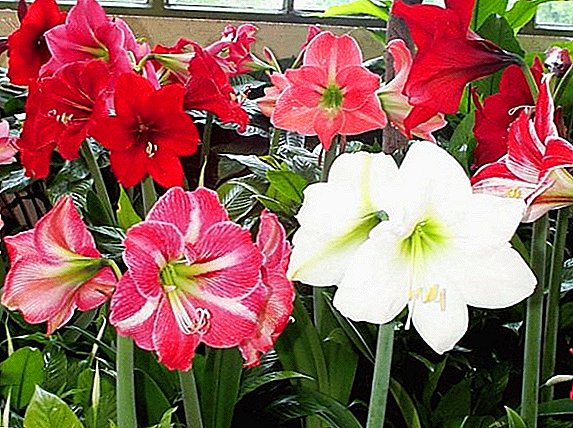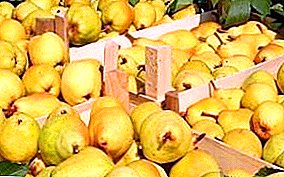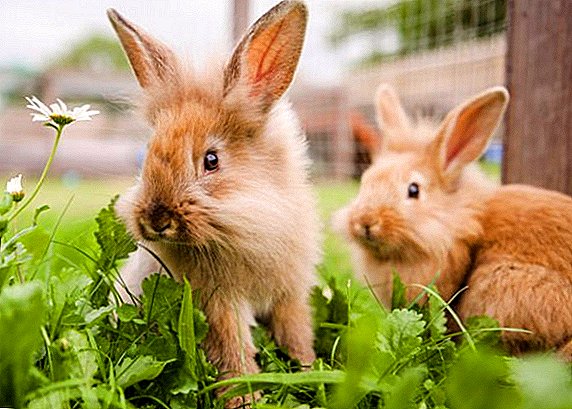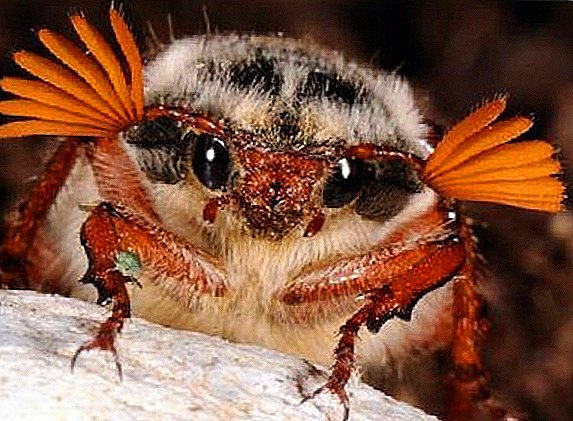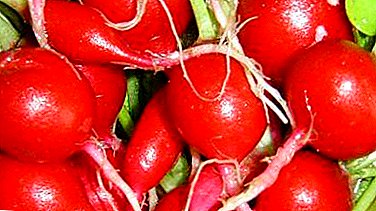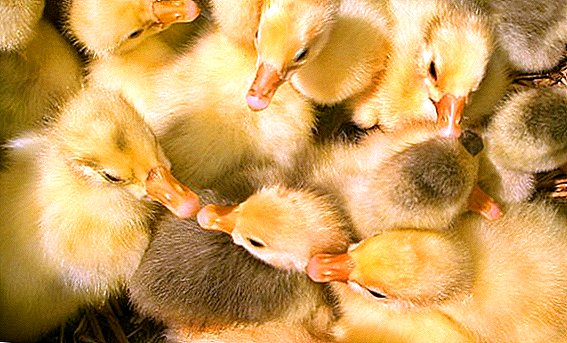 Gardeners are often unhappy with varieties of garden crops. However, most often they themselves are to blame for not getting the expected result, because they improperly care for strawberries. But each variety requires its own approach and certain conditions of detention. AND strawberry "lord" is no exception to these rules.
Gardeners are often unhappy with varieties of garden crops. However, most often they themselves are to blame for not getting the expected result, because they improperly care for strawberries. But each variety requires its own approach and certain conditions of detention. AND strawberry "lord" is no exception to these rules.
Characteristic strawberry varieties "Lord"
 This strawberry variety is famous for its magical taste and high yield. However, in order not to be deceived in expectations, you need to take into account some of the nuances in cultivation. Strawberry "Lord" was bred in the UK by local breeders. It is attributed to medium-late varieties, since the ripening period of the berries is rather extended (the end of June - the end of July) and only increases with time. The bushes of this litter are quite high - 60 cm and erect. Peduncles strong, but with a rich harvest need a garter, because under the weight of the fruit fall on the ground. Bright red berries are large (80-100 g), have a blunt-conical shape and have a delicate aroma and sour-sweet taste.
This strawberry variety is famous for its magical taste and high yield. However, in order not to be deceived in expectations, you need to take into account some of the nuances in cultivation. Strawberry "Lord" was bred in the UK by local breeders. It is attributed to medium-late varieties, since the ripening period of the berries is rather extended (the end of June - the end of July) and only increases with time. The bushes of this litter are quite high - 60 cm and erect. Peduncles strong, but with a rich harvest need a garter, because under the weight of the fruit fall on the ground. Bright red berries are large (80-100 g), have a blunt-conical shape and have a delicate aroma and sour-sweet taste.
Strawberry "Lord" is valued for its yield, and in the description of the variety (subject to the rules of agricultural technology) they promise up to six berries on one inflorescence. In fact, for one season, 2-3 kg of strawberries can be collected from one bush. "Lord" is characterized by longevity - with proper care, this variety gives a crop for ten years. Also this plant can be grown both on personal plots, and on an industrial scale.
In addition to the frost resistance of strawberries "Lord", its advantages include:
- High resistance to rot and strawberry mite;
- Good transportability;
- High yield;
- The presence of a large number of antennae for reproduction;
- Long fruiting period.
Among the shortcomings should be noted the high rate of growth of bushes and strict requirements for watering.
Did you know? Many mistakenly call garden strawberries strawberries. However, the strawberry differs from the strawberry in single-unit - female and male flowers are located in one bush, i.e. she is self-fertile. Therefore, strawberries have larger berries and higher yields.
Choosing a place for planting strawberries "Lord"
 If you choose a place for planting strawberries "Lord", avoid swampy areas. On them, the plant will not receive enough light, causing the yield is reduced, and the berries lose their properties - they will not be so sweet and large. The plot for planting should be smooth, although some say that strawberries will grow better on the uncool south-western slopes.
If you choose a place for planting strawberries "Lord", avoid swampy areas. On them, the plant will not receive enough light, causing the yield is reduced, and the berries lose their properties - they will not be so sweet and large. The plot for planting should be smooth, although some say that strawberries will grow better on the uncool south-western slopes.
Important! In the lowlands to grow strawberries will not work - it does not tolerate low temperature, winds and high humidity. Even if the strawberries on such a plot and will yield, it will be unhealthy, and berries - small.
Preparatory work before landing
In order for the strawberry to be pleased with its harvest, the soil on which it is planned to grow it must be sandy or loamy and slightly acidic (5.5-6.5 pH). On the sandy and clay soil, the berries will be small - they will not have enough moisture. Low yield of strawberries "Lord" will be on limestone, saline soils and with high acidity.
Important! If there is groundwater in the backyard, the beds should be made high..
The most fertile soil for strawberries is considered to be humus and rich in organic elements. Such soil can be made independently: in the fall, the collected foliage and manure are composted and poured in several layers of the earth, filled with water and left to flow until spring.
In agricultural technology of growing strawberries "Lord" use such a basic soil composition, varying it and selecting additional components:
- sawdust;
- humus;
- peat;
- sand.
To prevent the attack on strawberries of pests, the land is cleaned and watered with ammonia water before planting, and for weed control with a special solution. Beds for the "Lord" is desirable to form a week before planting. At the same time, their width should be at least 80 cm, and the distance between bushes - 80-100 cm.
The rules of planting strawberries varieties "Lord"
 In order for the beds with strawberries are not turned into thick jungle, when planting bushes need to be placed in a staggered manner, and not in one row. Then the plant will have enough space for growth, and the fruit - enough ventilation and sunlight for ripening. Strawberry seedlings "Lord" in the open ground planted in August. Before frost, the plant will have time to build up the root system and take root. Many gardeners tend to think that the best time to plant strawberries is early spring. During this period, it will not freeze, and over the summer it will have time to grow and gain strength. However, during spring planting of seedlings, flower stalks should be removed on a mandatory basis so that the strawberries do not waste their strength on them. Before planting, the soil should not be poured with water - it should be slightly damp.
In order for the beds with strawberries are not turned into thick jungle, when planting bushes need to be placed in a staggered manner, and not in one row. Then the plant will have enough space for growth, and the fruit - enough ventilation and sunlight for ripening. Strawberry seedlings "Lord" in the open ground planted in August. Before frost, the plant will have time to build up the root system and take root. Many gardeners tend to think that the best time to plant strawberries is early spring. During this period, it will not freeze, and over the summer it will have time to grow and gain strength. However, during spring planting of seedlings, flower stalks should be removed on a mandatory basis so that the strawberries do not waste their strength on them. Before planting, the soil should not be poured with water - it should be slightly damp.
Holes for seedlings should be 30 cm deep. They are filled with humus and a tablespoon of superphosphate, half a glass of ash and a teaspoon of potassium sulfate is added. All components are mixed, and only then strawberries are planted. Landing is best done on the principle of "under the film." To do this, you need to lay a bed with plastic wrap (preferably black) and make holes in it in front of the holes. The roots while hiding under the film, and vershok remains on top. When planting strawberries, try to locate the root system at ground level.
 If the seedlings have many leaves, they are removed, leaving only 3-4 located in the center. Long roots are shortened to 5 cm and before planting dipped in a talker based on clay, then placed in the hole, gently straightening the roots, and sprinkled with earth. Around the seedlings make a small earthen roller so that the water does not spread when watering. If your site is constantly wet soil and you can not find a place for strawberries, you can use the comb planting method. To do this, lay a strip width of 100 cm, on the sides of which are laid grooves for drainage of excess water.
If the seedlings have many leaves, they are removed, leaving only 3-4 located in the center. Long roots are shortened to 5 cm and before planting dipped in a talker based on clay, then placed in the hole, gently straightening the roots, and sprinkled with earth. Around the seedlings make a small earthen roller so that the water does not spread when watering. If your site is constantly wet soil and you can not find a place for strawberries, you can use the comb planting method. To do this, lay a strip width of 100 cm, on the sides of which are laid grooves for drainage of excess water.
Important! Different strawberry varieties are best planted away from each other, so that they do not peopoled.
Proper care is the key to a good harvest.
Strawberry "Lord" has good resistance to diseases and practically does not suffer from pests. Even if the plant is sick, it can be saved. For the prevention of diseases, it is necessary to regularly weed strawberries, remove dried leaves, mulch between rows, pollinate and apply potassium phosphate fertilizers.
Watering, weeding and loosening the beds
 "Lord" needs abundant watering. This is especially important at the time of the formation of buds and flowering. The volume of water depends on the degree of soil moisture. On average, under each bush you need to pour out a liter of water. At the same time, the stagnation of moisture and excess moisture adversely affect the taste of strawberries "Lord" and the weight of the berries. The ideal option - microdrop watering. Almost the entire vegetative period of the bushes emit special shoots - antennae. They take root, and a young bush appears. In rainy weather, it is advisable to cover the strawberries with foil.
"Lord" needs abundant watering. This is especially important at the time of the formation of buds and flowering. The volume of water depends on the degree of soil moisture. On average, under each bush you need to pour out a liter of water. At the same time, the stagnation of moisture and excess moisture adversely affect the taste of strawberries "Lord" and the weight of the berries. The ideal option - microdrop watering. Almost the entire vegetative period of the bushes emit special shoots - antennae. They take root, and a young bush appears. In rainy weather, it is advisable to cover the strawberries with foil.
Did you know? Garlic, radishes, carrots, onions, dill, beets and legumes are excellent precursors for strawberries, but right after cabbage, raspberries, cucumbers and solanaceae, it is impossible to plant strawberries and strawberries - the crop will be unimportant.
Weeding and loosening make it easier for moisture to get into the root system. When carrying out these operations use special garden tools.
Fertilization
Strawberry "Lord" is very sensitive to fertilizers and you need to feed it at least four times per season.
| Stage of development | How to feed strawberries "Lord" |
| Before planting or before the formation of the first leaflets (in the case planted in previous seasons) |
|
| After the emergence of the first leaves in strawberry "lord" to increase the yield |
|
| As soon as the fruit began |
|
| Before wintering | By mid-September, manure the cow with ash (0.5 cups per manure bucket). After 14 days, pour a solution of ash (cup), sodium sulfate (30 g), nitrophoska (2 tablespoons), water (bucket). Immediately before the cold under the bushes put humus or mullein. |
Important! Feed the "lord" only need mature organic matter, because its roots are close to the surface and there is a risk of getting burned.
Mulching between rows
 Mulching plays an important role in the care of strawberries - in the winter it protects from frost, in the summer it protects the fruits from pollution, retains moisture and allows loosening less often. Frosts can destroy strawberries, so you should resort to mulching. To do this, you can use pine needles: 10-cm layer perfectly protects the delicate plant from the cold. Mulch needles are also recommended for weed control. When the threat of frost has passed, old leaves are removed from the strawberry bushes, and after the appearance of new leaves, the beds are covered with a 5-centimeter layer of dry needles.
Mulching plays an important role in the care of strawberries - in the winter it protects from frost, in the summer it protects the fruits from pollution, retains moisture and allows loosening less often. Frosts can destroy strawberries, so you should resort to mulching. To do this, you can use pine needles: 10-cm layer perfectly protects the delicate plant from the cold. Mulch needles are also recommended for weed control. When the threat of frost has passed, old leaves are removed from the strawberry bushes, and after the appearance of new leaves, the beds are covered with a 5-centimeter layer of dry needles.
Harvesting strawberries
Since strawberries "Lord" fruits are perishable, then harvesting and storage must be approached responsibly. If you want to preserve the harvest for some time, then you need to pick berries for two to fully mature, while the fruits are still pink. In this form, you can store strawberries in the refrigerator for 2-3 days. The fruits to be transported must be removed from the bush along with the sepals, leaving small tails. Harvest time - after the dew dries in the morning or before sunset in the evening.
Important! Since the “lord” is a variety that bears fruit throughout the season, its fruits should be collected regularly.
 Harvest better placed in baskets or plastic (wooden) containers, covered with cotton cloth or porous paper. To strawberries did not let the juice, it should be laid in a single layer. Keep refrigerated. Before laying, wash and sort the berries is not recommended. In order to enjoy the delicious taste of berries in winter, you can use shock freezing. To do this, clean berries laid out in a single layer on a plate and put in the freezer. After freezing, the strawberries are put in a container or bag and put in the freezer.
Harvest better placed in baskets or plastic (wooden) containers, covered with cotton cloth or porous paper. To strawberries did not let the juice, it should be laid in a single layer. Keep refrigerated. Before laying, wash and sort the berries is not recommended. In order to enjoy the delicious taste of berries in winter, you can use shock freezing. To do this, clean berries laid out in a single layer on a plate and put in the freezer. After freezing, the strawberries are put in a container or bag and put in the freezer.
Did you know? Strawberries are a real storehouse of beneficial micronutrients and vitamins. It is rich in vitamin C (in six berries - as in one orange) and folic acid (more than in raspberries and grapes). In addition, the consumption of strawberries will help to normalize the work of the intestine, strengthen the walls of blood vessels, stabilize the immune system.
Everyone knows the simple truth: a good harvest depends on how comfortable the plant will feel. Competent care for strawberries "Lord" will allow more than one year to enjoy this delicious berry.


